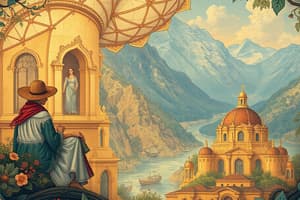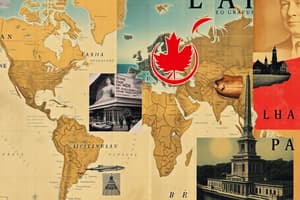Podcast
Questions and Answers
What are the main seasons experienced in Southeast Asia?
What are the main seasons experienced in Southeast Asia?
- Wet and Dry (correct)
- Winter and Summer
- Rainy and Sunny
- Harsh and Mild
Eratosthenes is known as the father of Geography.
Eratosthenes is known as the father of Geography.
True (A)
What is the predominant type of agriculture in Southeast Asia?
What is the predominant type of agriculture in Southeast Asia?
Rice cultivation
Southeast Asia is located near the ______.
Southeast Asia is located near the ______.
Match the following continents with their notable features:
Match the following continents with their notable features:
What is the main characteristic of an archipelago?
What is the main characteristic of an archipelago?
The Ring of Fire contains 500 volcanoes and experiences 50% of the world's earthquakes.
The Ring of Fire contains 500 volcanoes and experiences 50% of the world's earthquakes.
Name two insular countries in Southeast Asia.
Name two insular countries in Southeast Asia.
Sustainable Development addresses all the needs of the people without neglecting or sacrificing the __________.
Sustainable Development addresses all the needs of the people without neglecting or sacrificing the __________.
Which of the following religions is primarily practiced in Southeast Asia?
Which of the following religions is primarily practiced in Southeast Asia?
Match the following countries with their classification:
Match the following countries with their classification:
Animism is a belief system where individuals do not ascribe spirits to objects in their environment.
Animism is a belief system where individuals do not ascribe spirits to objects in their environment.
Who is the founder of Buddhism?
Who is the founder of Buddhism?
Which concept describes a center of power that extends to subjects without boundaries in ancient Southeast Asian kingdoms?
Which concept describes a center of power that extends to subjects without boundaries in ancient Southeast Asian kingdoms?
Java has the largest population of any island on __________.
Java has the largest population of any island on __________.
Flashcards
Physical Geography
Physical Geography
Study of Earth's physical features, like landforms, climate, and natural resources.
Human Geography
Human Geography
Study of human societies, their cultures, and how they interact with the environment.
Eratosthenes
Eratosthenes
Considered the 'Father of Geography' for his contributions to the field.
Southeast Asia Location
Southeast Asia Location
Signup and view all the flashcards
Southeast Asia Seasons
Southeast Asia Seasons
Signup and view all the flashcards
Archipelago
Archipelago
Signup and view all the flashcards
Strait
Strait
Signup and view all the flashcards
Ring of Fire
Ring of Fire
Signup and view all the flashcards
Biodiversity
Biodiversity
Signup and view all the flashcards
Sustainable Development
Sustainable Development
Signup and view all the flashcards
Southeast Asian Countries
Southeast Asian Countries
Signup and view all the flashcards
Animism
Animism
Signup and view all the flashcards
Spirit Houses
Spirit Houses
Signup and view all the flashcards
Theravada Buddhism
Theravada Buddhism
Signup and view all the flashcards
Kinship Practices
Kinship Practices
Signup and view all the flashcards
Ethnolinguistic Groups
Ethnolinguistic Groups
Signup and view all the flashcards
Study Notes
Geography Overview
- Geography encompasses the study of location, distribution, interaction, and frequency of human and physical elements on Earth’s surface.
- Divided into two branches:
- Physical Geography: Natural features like cities, migration, and resources.
- Human Geography: Man-made aspects including culture, traditions, practices, and religions.
Father of Geography
- Eratosthenes known as the "Father of Geography."
Continents
- Asia: Largest continent, diverse geography.
- Other continents include Europe, Antarctica, Africa, South America, Australia, and North America.
Southeast Asia Geography
- Located in the easternmost part of Asia, near the Equator (0 degrees).
- Borders:
- East: Pacific Ocean
- South: Australia and Indian Ocean
- West: Bay of Bengal and Indian Ocean
- Experiences two main seasons: wet and dry.
Physical Characteristics Influence
- Mountains have shaped ethnolinguistic groups.
- Monsoon rains are vital for agriculture, enhancing irrigation and hydroelectric power.
- Predominant crop: Rice; also corn, taro, vegetables, coconuts, and pineapples.
Economy of Southeast Asia
- Key sectors: manufacturing, export, and services.
- Richest country: Singapore.
Key Geographic Terms
- Archipelago: Cluster of small islands.
- Strait: Narrow waterway connecting two larger bodies of water.
- Ring of Fire: Area with 900 volcanoes, where 90% of earthquakes occur.
- Biodiversity: Variety of life forms in an environment.
- Sustainable Development: Meeting people's needs without harming the natural environment.
Countries in Southeast Asia
- Total: 11 countries including Singapore, Myanmar, Thailand, Malaysia, Laos, Philippines, Vietnam, Indonesia, Brunei, Cambodia, East Timor (Timor Leste).
- Mainland: 5 countries (Myanmar, Thailand, Laos, Cambodia, Vietnam).
- Insular: 6 countries (Philippines, Malaysia, Indonesia, Singapore, Brunei, Timor-Leste).
Human Geography in Southeast Asia
-
Religion:
- Animism: Spiritual beliefs in natural elements.
- Spirit houses: Gifts for spirits.
- Theravada Buddhism, prominent due to accessible teachings.
- Hinduism features deities like Shiva, Vishnu, and Brahma.
-
Social Structures:
- Kinship practices lean towards bilateral and matrilocal traditions.
- Families often live near one another to maintain ancestral ties.
- Women's roles have evolved, gaining more freedom over time.
-
Historical Empires:
- Flourishing kingdoms from 900 to 1400 CE influenced by Chinese and Indian cultures.
-
Power Dynamics:
- Deva raja concept emphasized divine kingship.
- Mandala structure focused on a single leader's influence over subjects.
Population Insights
- Java: Largest island population globally.
- Southeast Asia population around 668 million (8.54% of the world).
- Philippines population recorded at 115.6 million (2022).
Cultural Elements
- Language and ethnicity are primary means of group categorization.
- Factors influencing ethnolinguistic group spread:
- Resource migration
- Political changes
- Cultural assimilation
Ethnolinguistic Groups
- Defined by shared language, culture, and ethnicity.
- Geographic features, particularly rivers, play a significant role in the development of groups in the mainland region.
Studying That Suits You
Use AI to generate personalized quizzes and flashcards to suit your learning preferences.




